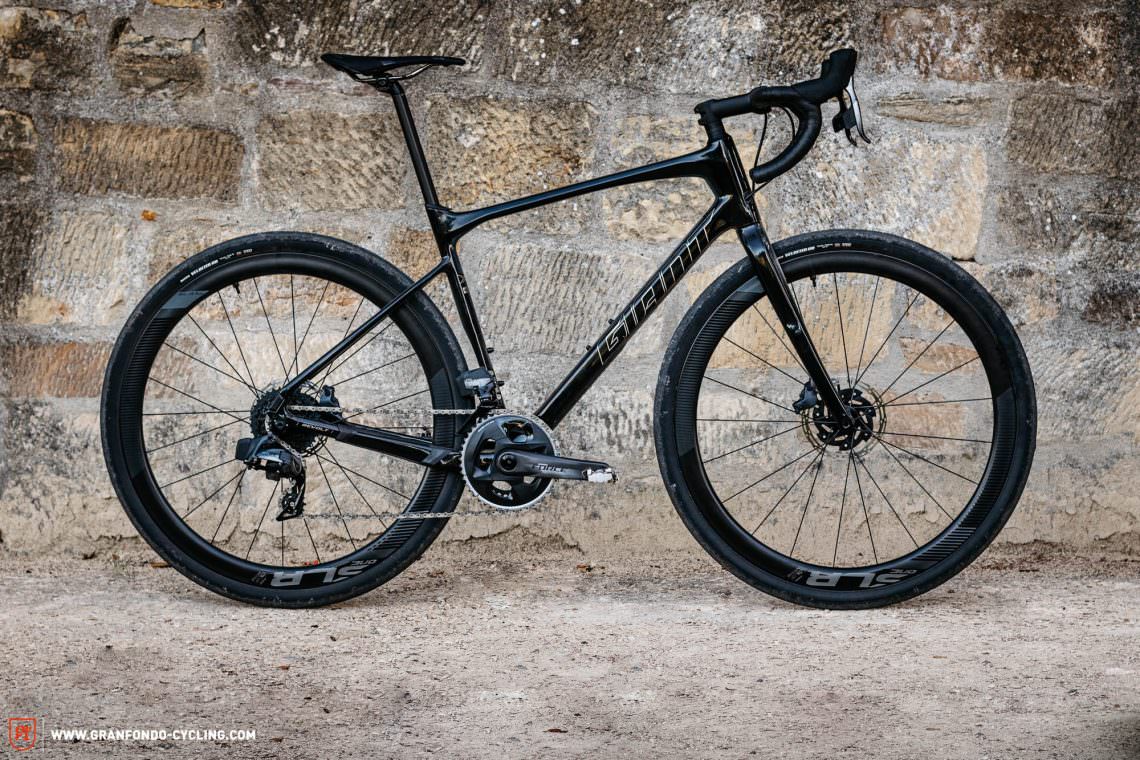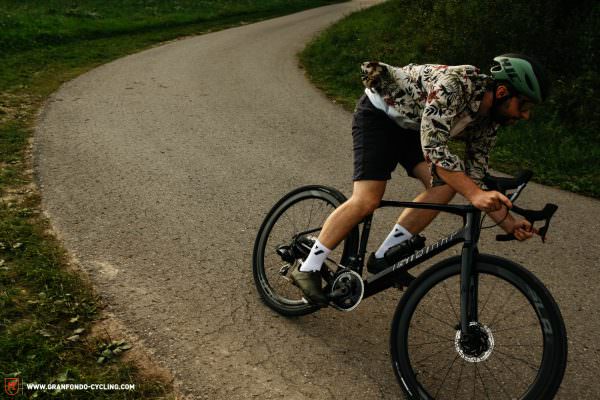The 2020 Giant Revolt Advanced Pro Force wants you to get off the beaten track and ride away from tarmac, concrete and air pollution. But how does this € 4,499 gravel bike feel out in the wild?
Click here for an overview of the best gravel bike 2020 group test.

Our first reaction to the Giant Revolt Advance Pro Force can be summarised as “pleasantly surprised”. The subtle, understated colours come across as modern and up to date. Indeed, the gravel category in Giant’s lineup relatively recent, with the Revolt only having become a part of the range in 2018. But riding off road isn’t new for Giant: the TCX Advanced SX cyclocrosser already made a very good impression when we tested it. The off-road concept of the TCX is based on a stiff, UCI compliant frameset paired with vibration damping D-Fuse components – and has now been modified for a more comfort-oriented long-distance setup in the form of the Revolt. For € 4,999 you get a bike equipped with a 2×12 SRAM Force eTap AXS drivetrain with 46/33 t chainrings and a 10-33 t cassette. The large 700 x 40C MAXXIS Velocita AR tires provide additional comfort and are fitted on Giant’s own SLR 1 Disc carbon wheels. Comfort is also the keyword of the proprietary Contact SLR D-Fuse components: the carbon bars and seatpost are designed to take the sting out of bumps, vibrations and uneven terrain. Last but not least, the “Smart Mount” mounts on the fork allow you to fit a rack, while at the rear, mounting points are hidden under neatly concealed covers. Our size M/L test bike weighed in at 8.24 kg, making it the second lightest bike in our group test.

The Giant Revolt Advanced Pro Force in detail
Drivetrain SRAM Force eTap AXS
Gearing 46/33 t and 10-33 t, 2×12
Brakes SRAM Force HRD, 160/160 mm
Handlebar Giant Contact SLR D-Fuse Carbon, 400 mm
Stem Giant Contact SL, 100 mm
Seatpost Giant D-Fuse SL Carbon, 20 mm offset
Wheels Giant SLR 1 Disc Carbon
Tires MAXXIS Velocita AR 700 x 40C

The “Smart Mount” bosses on the fork let you fit a rack.

The fork will happily take wider tires.

At the rear, the 700x40C MAXXIS Velocita AR tires are the biggest you’ll be able to fit. That’s not because of the frame, but the clearance between the tire and SRAM Force eTap AXS drivetrain.

With lots of seatpost exposed, you’ll start to bob up and down when pedalling hard.
| Size | S | M | ML | L | XL |
|---|---|---|---|---|---|
| Seat tube | 450 mm | 470 mm | 490 mm | 510 mm | 530 mm |
| Top tube | 540 mm | 550 mm | 565 mm | 575 mm | 590 mm |
| Head tube | 135 mm | 150 mm | 165 mm | 180 mm | 195 mm |
| Head angle | 70.5° | 70.5° | 71.0 | 71.0° | 71.0° |
| Seat angle | 73.5° | 73.5° | 73.0° | 73.0° | 73.0° |
| Chainstays | 425 mm | 425 mm | 425 mm | 425 mm | 425 mm |
| Wheelbase | 1,020 mm | 1,020 mm | 1,020 mm | 1,046 mm | 1,062 mm |
| Reach | 375 mm | 381 mm | 385 mm | 391 mm | 402 mm |
| Stack | 558 mm | 572 mm | 588 mm | 602 mm | 616 mm |
The Giant Revolt Advanced Pro Force in review
After the first few metres, it becomes immediately clear that this bike wasn’t just designed for pootling. The stiff bottom bracket and efficient propulsion of the bike combine seamlessly with excellent comfort and long-distance geometry. The compact position and effective damping of the bars provide yet more comfort, but you will still feel the sting of potholes if you hit them. It’s totally different at the rear. The large amount of exposed D-Fuse seatpost takes the sting out of anything and scores highly in terms of compliance. But that high level of flex doesn’t only swallow impacts, it also results in some bobbing when you start pedalling hard.

Tires with more pronounced tread for better off-road performance.


The biggest bike manufacturer in the world adds a versatile bike with lots of comfort to its portfolio – with lots of seatpost exposed, it might even be a little too compliant at the rear.
The Giant scores with its good straight-line stability and is good-natured through the corners, though it requires significant input to not run wide through tight corners. Overall, the Revolt Advanced Pro Force inspires a lot of confidence, making it suited to off road newbies who want to try their hand at more technical terrain. The natural environment for the Giant and where it feels happiest is no doubt blasting along forest roads and tracks. That said, the Giant also handles tarmac with aplomb. Put a bit more pressure in the tires and it will happily go out for longer road rides making it an all-rounder capable of a bit of everything.

Conclusion
If you’re looking for a good-natured and comfortable all-rounder that can find its feet on nearly any terrain, then the Giant Revolt Advanced Pro Force could be a great choice! At € 4,499 and a weight of 8.24 kg, the Giant is a solid but sporty proposition that will be a great companion for beginners. But if you’re looking for a direct and precise handling gravel bike, the Revolt Advanced Pro Force could be a bit too relaxed for you.
Tops
- stable ride
- D-Fuse components generate lots of comfort
- clever mounting points for versatile luggage options
Flops
- handles a little vaguely through corners
- seatpost can bob when lots of it is showing
Riding Characteristics
4Agility
- cumbersome
- playful
Stability
- nervous
- confident
Handling
- demanding
- balanced
Fun factor
- boring
- lively
Value for money
- terrible
- very good
For more info: giant-bicycles.com
Click here for an overview of the best gravel bike 2020 group test.
All bikes in test: Argon 18 Dark Matter | Cannondale Topstone Carbon Ultegra RX | Canyon Grail AL 7.0 | Cervélo Áspero | Giant Revolt Advanced Pro Force | Kona Libre AL | Liteville 4-ONE MK1 | OPEN WI.DE. | Pivot Vault Team Force | ROSE BACKROAD GRX RX810 Di2 | Santa Cruz Stigmata CC | Specialized Turbo Creo SL Expert EVO | Standert Pfadfinder | Trek Domane SLR 9 eTap
No, it’s not about perfect race tracks, it’s about efficiency. Fast, fleet-footed and efficient – those who want to speed along high-speed passages need a defined and spritely bike that accelerates with ease and efficiency. Nevertheless, reliable components are important too. We interpret “Smooth tarmac” bikes as follows: Hard efforts at high speeds with a maximum efficient bike on a consistently well-paved road. Effort-joy ratio: 80:30 (not everything has to be 100%!)↩
… also known as bike riding. Broken-up roads in the hinterland, deadlocked gravel roads, loose surfaces – sometimes muddy, sometimes bone-dry. For this, it takes bikes with super all-round, handling and wearing qualities uphill and downhill. Effort-joy ratio: 50:50↩
If you want to use your bike almost every day, you usually do not need an extremely tuned racing machine. Solid components, which are able to cope with the rigours of continuous usage in any kind of weather, are part of the basic equipment. At the same time, the bike should have practicable details: integrated fenders/assembly options, luggage racks/attachment points and a light system or at least the option of installing bike lights. The position on the bike should be rather relaxed, the overall comfort high, so that the Afterwork Ride becomes a cure and not a curse. Effort-joy ratio: 30:70↩
You can find more info about our rating system in this article: Click here! ↩
Did you enjoy this article? If so, we would be stoked if you decide to support us with a monthly contribution. By becoming a supporter of GRAN FONDO, you will help secure a sustainable future for high-quality cycling journalism. Click here to learn more.
Words: Photos: GRAN FONDO-Team







